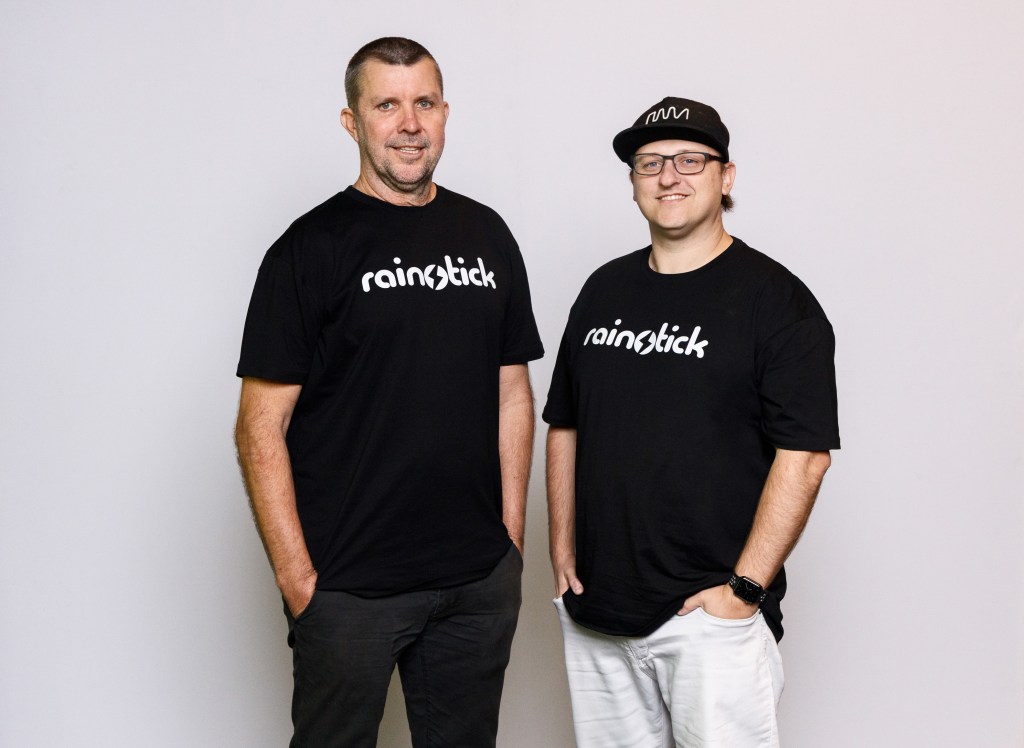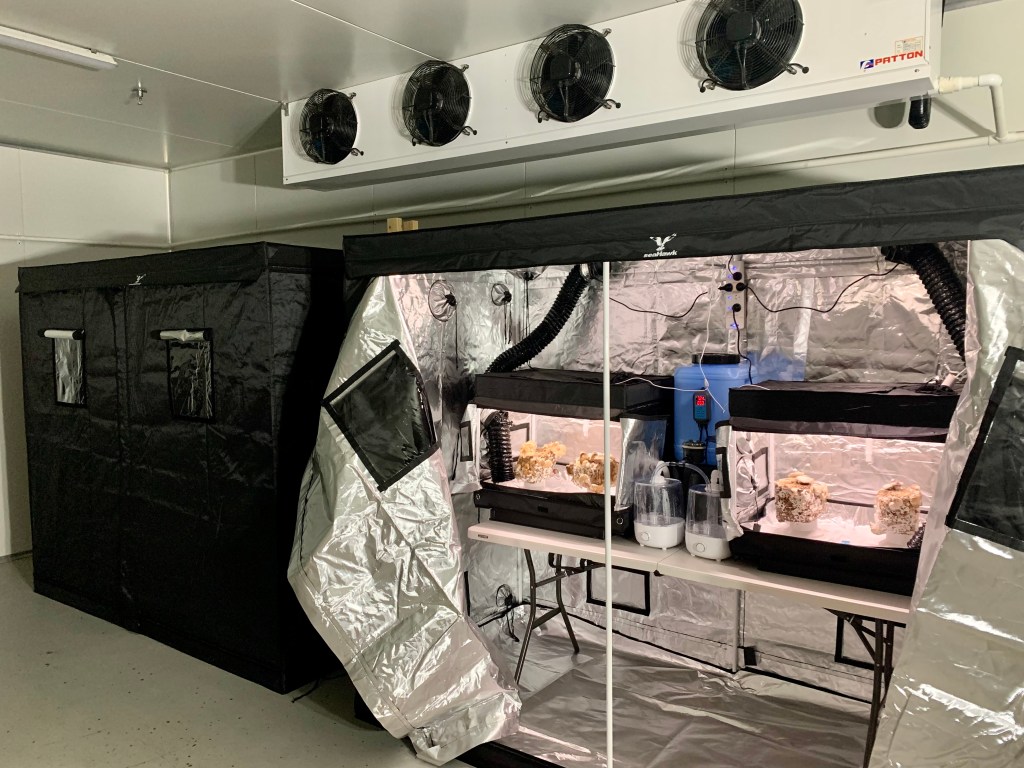CSIRO names Rainstick a “deep-tech gamechanger”.
Any gardener will tell you that their plants grow best after a thunderstorm. And when Darryl Lyons and his co-founder, Mic Black, started digging into the scientific literature about this notion, they found it had been studied all the way back to the 1700s.
The Cairns-based pair found a lot of evidence that all plants boomed after lightning, but they were drawn to some Japanese papers showing that you could make mushrooms flourish by exposing them to a lightning-like current created by an enormous, expensive device.
Black, a serial inventor, tinkerer and founder, reckoned he could come up with a way to do it simpler and cheaper.

Then Lyons learned that his ancestors, the Maiawali from far-western Queensland, were known as the “rainmakers” among the Indigenous peoples of the arid interior.
“They used a lightning stick that was buried in the ground,” Lyons says. “They put a bit of metal oxide on a stick to attract lighting and then that was used as the ceremony stick – the ‘rainstick’ – to do all the dancing to bring in the rain.”
Meanwhile, Black had succeeded in creating a small, cheap “lightning” generator that sat on a rack about 30cm above cultivated mushrooms.
“We made our own little ‘rainsticks’,” explains Lyons. “We can run Mic’s device off a solar panel. It takes a really small voltage, and we turn that into 50,000 volts for a fraction of a second to create negative ions in the air, and then we push that into the plant for it to use its internal system to say, ‘Hey we’re on. Let’s grow quicker and bigger.’”
It seemed only natural to call their start-up company Rainstick, after Lyons’s people’s rainmaking methods.
“Our first experiments went really well,” says Lyons. “The industry told us that an 8% yield increase would be a game changer. On our first crack at it we had them grow 15% quicker with 15% more yield.”
“This is something we want to spend the next 10 years on. It’s got passion, it’s got purpose, it’s got impact.”
– Darryl Lyons, co-founder Rainstick
Since those early experiments, they claim to have achieved a further 5% yield and stopped green mould which can cause serious productivity loss for commercial growers.
In theory, the lightning treatment should also work with plants, but Black and Lyons chose to concentrate on mushrooms because they grew quicker, meaning they could test more options in less time. The next six months will see a lot more experiments to optimise how often and how much the fungi get zapped.
Lyons, 52, is no stranger to business. He was co-founder of the food supply-chain tracking app, Escavox. And he’d previously owned an NBN installation business that employed 60 people. Due to his experience, he thought he wouldn’t qualify for Dream Ventures, the indigenous shark tank funded by Nicola and Andrew Forrest’s Minderoo Foundation.

But he threw his hat in the ring anyway and got through, winning $20,000 in funding. “It’s propelled us forward,” says Lyons. “It’s given us confidence that this is something we want to spend the next 10 years on. It’s got passion, it’s got purpose, it’s got impact.
“We’ve done the design and the hard work and shown that it works and now we’re opening up an investment round and just starting to get some investors to put some cash in.”
“We’ve taken in $200,000 so far and we’ve got quite a few people interested. We just need to get the results from the next round of tests and we’ll try to bring in $750,000 to get us through to later next year when we think we’ll have products to sell.”
Rainstick was further boosted this week by the announcement that the CSIRO had named it among “10 deep-tech game changers from Australia’s universities and research community” to develop their innovative ventures through the science organisation’s ON Accelerate programme.
Teams will be partnered with experts over a 14-week program to equip them to take their products to market.
CSIRO Chief Executive Larry Marshall said the ON program has been part of transforming Australian innovation since 2015. “CSIRO’s ON Program has become a world-leading innovation catalyst because it inspires Australia’s scientists to turn their science into real world solutions for our greatest challenges,” Marshall said.
“ON recognises that innovation thrives on diversity and doing things differently. When you redefine old school paradigms of leadership, you can drive financial performance and reinvent industries.”
The 10 teams selected for next year’s CSIRO ON Accelerate:
- DHI, connected to Monash University, is harnessing AI to improve regulation technology to better detect and report discrepancies of listed companies’ disclosures.
- Green Shield, also from Monash University, offers a class of materials that provide unique solutions for object camouflage, including radio frequency shielding.
- Originating out of the University of Technology Sydney, the v2Algae team is creating a new biotechnology specialty ingredient manufacturing segment for Australia. This team is partnering with another great company, one born out of CSIRO technology, v2food
- Rainstick combining indigenous knowledge systems and modern electrokinetics to encourage fungi and plants’ natural systems to grow faster and increase yield. Rainstick is working with researchers at James Cook University
- The SpritzOM team from Telethon Kids Institute is working to develop a low-cost nasal vaccine to prevent ear infections. There are no approved vaccines that target the major pathogen responsible for the most common ear infections.
- The Application Development team at WEHI has developed an information system to manage animals in research environments. Through venture creation, the team will deliver a solution that helps organisations working with animals improve their ethical treatment, lower the cost and improve efficiency
- Thaum, a startup team from the ANU Research School of Physics deep-tech incubator Momentum, is commercialising WhalePOD. WhalePOD’s disruptive vision capabilities help offshore industries implement harm mitigation strategies to protect marine mammals
- Cognitag, a team from CSIRO is helping tap into the phenomenal un-mined potential of Internet of Things connected devices. They’re working to make smart devices even smarter
- CSIRO’s Reduced Sugar Juice team is working on naturally reducing the sugar content of juice drinks by up to 70 percent without negatively affecting their nutritional value
- And CSIRO’s UpCell team has developed a process technology for the super-efficient and scalable production of specialised performance proteins.
- *(List supplied by CSIRO)